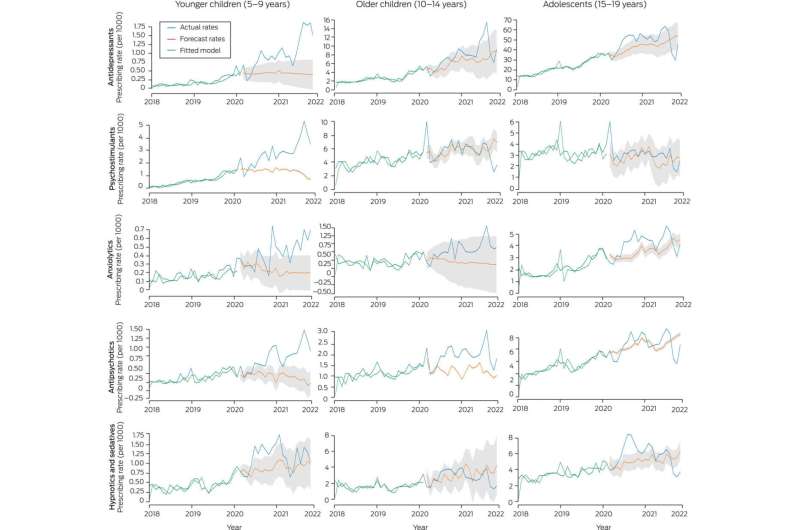This article has been reviewed according to Science X's editorial process and policies. Editors have highlighted the following attributes while ensuring the content's credibility:
fact-checked
peer-reviewed publication
trusted source
proofread
Study: Australian children needed more mental health medications during the pandemic

Data from General Practice (GP) visits has found doctors prescribed up to three-and-a-half times more antidepressants and anti-anxiety medication for children aged five to nine than forecast in pre-pandemic mapping.
Psychotropic medications include antidepressants, anxiolytics (anti-anxiety medications), psychostimulants for attention deficit disorders, antipsychotics, and hypnotics and sedatives.
A team including researchers from the Australian Institute of Health Innovation (AIHI) at Macquarie University and the not-for-profit primary care data innovation group Outcome Health analyzed anonymized information from 1.4 million GP visits to 660 clinics in Victoria and NSW made by children aged between five and 19, between 1 January 2018 and 30 November 2021.
Lead author Dr. Rae-Anne Hardie from Macquarie University says between January 2020 and November 2021, GPs wrote more prescriptions for psychotropic medications for all age groups compared to predictive mapping based on data from 2018—2020.
"Previous research found that children and adolescents suffered harm to their mental health from being cut off from their usual support structures, including social activity, extended family and school," Dr. Hardie says.
"What we have seen in the data we analyzed certainly supports both of these findings."
The GP data showed peaks and troughs, but at their highest point, the five‑to‑nine age group were being prescribed antidepressants at a rate of approximately 1.75 prescriptions per thousand, up from the predicted 0.5 per thousand. For the 10 to 14 age group, the high was 16 per thousand compared to the expected rate of about 8 per thousand.
Anxiolytics were up from a predicted 0.25 prescriptions per thousand to a peak of 1.5 per thousand for both the five- to nine and 10. to 14 age groups. Psychostimulants for ages five to nine were also markedly higher than mapping predictions, up from one per thousand to a high of five per thousand.
In addition to the overall number of prescriptions increasing, the proportion of scripts with five repeats also rose, with a five percent increase in the first month of the pandemic, up from 9.7 percent in February 2020 to 14.7 percent in March 2020.
"Our findings underline the importance of general practice in the provision of mental health care in this country," Dr. Hardie says.
"Our research findings underscore the very important role of general practice, particularly when the health care system is under stress and struggling to find the capacity to meet mental health care needs."
Outcome Health Research Director Dr. Chris Pearce has been a GP in Melbourne for more than 35 years, and he says even in non-crisis times, general practice is responsible for the vast majority of mental health prescribing.
"Yes, people of all ages were unable to see their psychiatrists as usual due to lockdowns, but figures from the Australian Institute of Health and Welfare show that nearly 85 percent of mental health prescribing is done by GPs, compared to just eight percent by psychiatrists," he says.
"GPs provided the vast bulk of mental health care in this country before and during the pandemic, and they continue to do so now the global COVID-19 crisis has passed."
"In a normal week, GPs would see about a third of appointments for mental health care, a third for a combination of mental and physical care, and only a third are for physical care alone."
"Longer waiting times and more difficult access to pediatric psychologist and psychiatric services have inevitably led to greater reliance on general practitioners."
The research furthered a collaborative partnership facilitated by the Digital Health Cooperative Research Centre (DHCRC) aimed at developing an evidence base to address the longer-term impacts of COVID-19.
"This data is a stark reminder of both the personal and societal impact of the global pandemic on all Australians, and especially in some of our most vulnerable communities," says DHCRC CEO Annette Schmiede.
"Building evidence-based research is critical to ensure that those most impacted by COVID-19 receive the best support possible moving forward."
The work is published in the Medical Journal of Australia.
More information: Rae‐Anne Hardie et al, Psychotropic medication prescribing for children and adolescents by general practitioners during the COVID ‐19 pandemic, Medical Journal of Australia (2023). DOI: 10.5694/mja2.51942




















